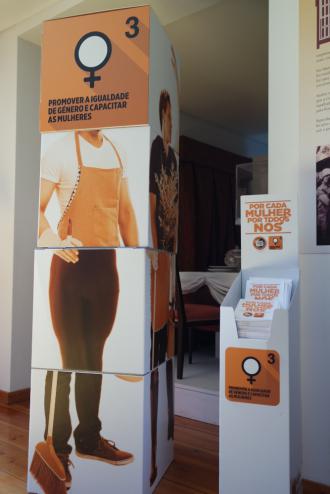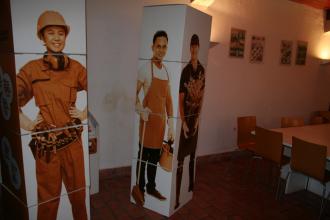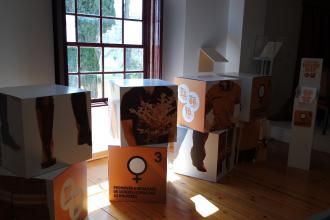How to do it step by step
1st Step:
What do we want to focus on and why?
The promotion of gender equality is essential to eradicate poverty and achieve sustainable human development. Above all, we must remember that gender equality is a human right: women have the right to live with dignity and enjoy conditions that enable them to achieve social and economic security. Empowering women contributes towards the health and productivity of their family, community and nation. So, when we talk about gender equality we are also talking about human rights and sustainable development for all of us.
2nd Step:
Location
Having identified the appropriate MDG, chosen the specific theme (equality in employment and occupation) and decided what type of installation we wanted (visual, educational, interactive etc.), we then needed to choose the location for it. We wanted a location providing a natural association between the topic of the new installation and the existing objects displayed. Choice of location will influence various aspects of the installation, such as its size and materials to be used.
3rd Step:
Get to work
"Man dreams and the work is born" – but who will turn the installation concept into reality? A good idea is only fully achieved when its implementation matches the original idea. So, we must contact the appropriate service providers who can help us meet our objectives. We should point out that many museums already know a number of contractors who help facilitate the museum’s activities and they could also play an important role in this installation.
In selecting contractors, we must have a clear idea of what we want, how we want to achieve it and by when. However, we must also be open to suggestions for improvements from other stakeholders.
4th Step:
The materials
The installation may or may not have a set of support materials (signposting, subtitling, etc.) that further raise awareness on the issue in question. What kind of materials can we develop to ensure that the installation is creative, educational and informative? How can we encourage visitors to act and adopt sustainable behaviours? Once we are clear on the answers to these
questions, we should carry out a SWOT analysis, identifying strengths, weaknesses, opportunities and threats. This analysis will help us to adjust certain details that may be decisive in achieving the installation’s purpose.
5th Step:
The message
A clear and simple message can help ensure that visitors reflect on the issue at hand. So, there are certain requirements that we cannot ignore:
Research: ensure that information presented through the installation is based on current and correct data from credible sources. If the data is complex, confusing or contradictory, the entire message is undermined.
Writing: use language that is accessible to all audiences and pay attention to typography (type, size, font, colour etc.) in order to facilitate reading. The message should not be biased and should present arguments based on facts that can be substantiated by the visitor.
Final text: we must ensure that facts are consistent and that we start by presenting the global dimension before moving on to local aspects to keep the visitor interested in the subject. The human dimension must always be present as well to ensure consistency between values and action. The messages should be highlighted in both the installation and the support materials.
6th Step:
Approval of the support materials
Leaflet: What are we talking about and why? What do we stand for and which solutions do we want to promote? These are some of the key aspects for addressing the issues of Global Citizenship Education. In this installation, we tried to present the issue of equality between women and men as a challenge that has lasted for more than five decades. Through a timeline displaying this history, we illustrate that equality is a matter of human rights, enshrined in key documents at international and national level yet ignored in too many countries.
The leaflet should have a visual link to the topic under discussion. If possible, it is advisable to include a key phrase that introduces and summarizes your key message.
To address the issue of MDG3, our key message was "For every woman, for all of us". We believe that this phrase sums up the important role played by women in building a global world where all men and women have a place.
Signpost: alerts visitors to the installation and the theme. Opt for a picture with a brief caption.
Totem display stand: this has the dual function of displaying the leaflets and identifying the installation within the museum.
7th Step:
Setting up the installation
The installation, designed to present gender equality, is innovative and demystifies the prejudices bound up in professions traditionally associated with the male sex. Through nine cubes measuring 50 cm x 50 cm x 50 cm, each displaying parts of images of six professions and a side of general information, visitors are confronted with some myths concerning certain professions in modern societies. The idea of the installation is for visitors to combine the cubes in different ways to form images, mixing professions and genders, thereby confronting their own gender stereotypes in relation to certain professions.
The installation is placed in the section of the museum where objects illustrate the domestic environment of families between the 19th and mid-20th centuries. Back then, particular tasks and leisure activities had to follow certain predefined rules. Both play and joining a profession were constrained by rules and social habits, dependent on both the family's social status and the child's gender.
We sought, by linking the installation to these objects, to highlight the huge gains already achieved on the issue of gender equality and, at the same time, draw attention to what remains to be done.
8th Step:
Publicity and communication Plan
The installation was first publicised in March 2015 to coincide with the month's theme: "European Year for Development - Women and Girls".
We started the campaign with a teaser on Women's Day and during the month we disseminated information about the situation of women and girls around the world in various sectors such as education, employment, health and family relationships. Our publicity culminated in the photo album that was released later in the month..
9th Step:
Inauguration of the installation
Depending on the size and resources of the museum, and when appropriate, you may wish to organize an inauguration for which different approaches may be used: debates, movies, family activities, and so on.
On the question of gender equality, one interesting activity to consider is presenting the museum staff and their functions, through a diagram showing the number of men and women and their professional status. This activity can be a starting point for involving city residents and collaborators of the City Museum.




















